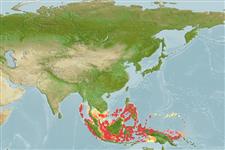Teleostei (teleosts) >
Clupeiformes (Herrings) >
Dorosomatidae (Gizzard shads and sardinellas)
Etymology: Anodontostoma: Greek, ana = up + Greek, odous = teeth + Greek, stoma = mouth (Ref. 45335).
More on author: Bleeker.
Environment: milieu / climate zone / depth range / distribution range
Ecology
Marine; brackish; pelagic-neritic; depth range 0 - 50 m (Ref. 188). Tropical; 15°N - 8°S, 89°E - 155°E (Ref. 188)
Indo-Pacific: Indian Ocean (Andaman Islands - a single Day specimen), Java Sea, the Philippines and eastward to Bismarck Archipelago.
Size / Weight / Age
Maturity: Lm ? range ? - ? cm
Max length : 18.0 cm SL male/unsexed; (Ref. 188)
Dorsal spines (total): 0; Anal spines: 0; Anal soft rays: 22 - 28. Body depth increasing with size of fish. Second supra-maxilla a mere splint. Lower gill rakers 100 to 166; longest gill rakers on lower part of arch less than corresponding gill filaments. Teeth on hind edge of scales wider than gaps between them; a median series of pre-dorsal scales. A large dark mark behind gill opening, followed by longitudinal streaks along flank.
Occurs inshore. Its biology is probably similar to A. chacunda.
Life cycle and mating behavior
Maturities | Reproduction | Spawnings | Egg(s) | Fecundities | Larvae
Whitehead, P.J.P., 1985. FAO Species Catalogue. Vol. 7. Clupeoid fishes of the world (suborder Clupeoidei). An annotated and illustrated catalogue of the herrings, sardines, pilchards, sprats, shads, anchovies and wolf-herrings. FAO Fish. Synop. 125(7/1):1-303. Rome: FAO. (Ref. 188)
IUCN Red List Status (Ref. 130435)
Threat to humans
Harmless
Human uses
Fisheries: subsistence fisheries
Tools
Special reports
Download XML
Internet sources
Estimates based on models
Preferred temperature (Ref.
123201): 28.1 - 29.1, mean 28.7 °C (based on 206 cells).
Phylogenetic diversity index (Ref.
82804): PD
50 = 0.6250 [Uniqueness, from 0.5 = low to 2.0 = high].
Bayesian length-weight: a=0.00912 (0.00433 - 0.01920), b=3.04 (2.87 - 3.21), in cm total length, based on LWR estimates for this (Sub)family-body shape (Ref.
93245).
Trophic level (Ref.
69278): 3.1 ±0.3 se; based on size and trophs of closest relatives
Resilience (Ref.
120179): High, minimum population doubling time less than 15 months (Preliminary K or Fecundity.).
Fishing Vulnerability (Ref.
59153): Low vulnerability (12 of 100).
